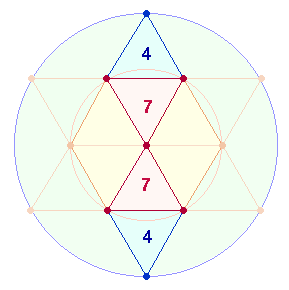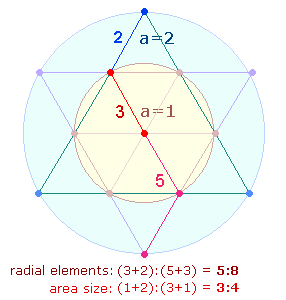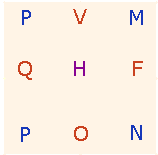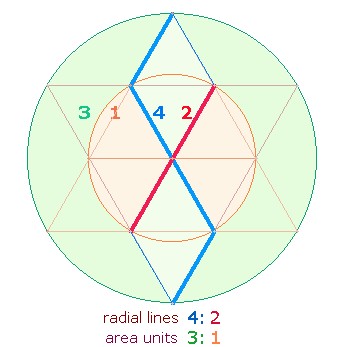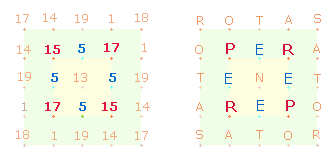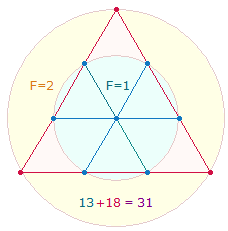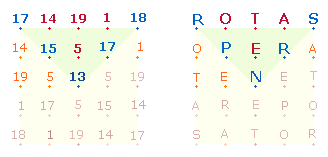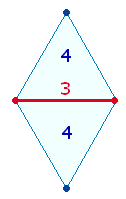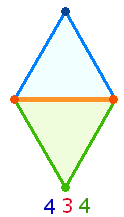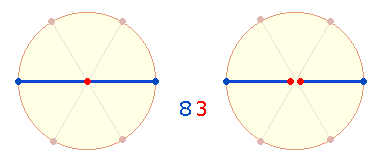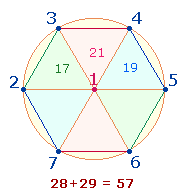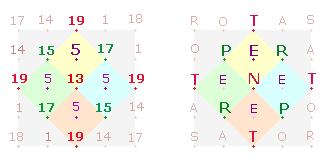Alphabets; gematric calculator
Ovid's
and Shakespeare's epitaphs
Three Augustan Poets + Shakespeare
a)
Interrelations
b) Relations to VESTA and the SATOR Square
c) Adding Shakespeare's Values
In the previous chapter I dealt with the full names of Vergil, Horace
and Ovid and found some evidence that Shakespeare's values harmonized with
theirs. Now I have a look at their initials and wonder what they have to say.
a)
Interrelations
1.
The
three Augustan poets stand for the sublime wisdom of the decimal system. The
gematric art of divine providence can also be found in their initials which
form a square of 3*3 letters. Their values
can be established vertically and horizontally.
2.
Let's
first look at the vertical groups which divide up in praenomen,
nomen
gentilicium and cognomen:
|
|
NS |
FS |
sm |
FV1 |
FV2 |
sm |
total |
|
P Q P |
46 |
24 |
70 |
25 |
9 |
34 |
104 |
|
V H O |
42 |
24 |
66 |
12 |
9 |
21 |
87 |
|
M F N |
31 |
25 |
56 |
31 |
10 |
41 |
97 |
|
|
119 |
73 |
192 |
68 |
28 |
96 |
288 |
|
96:192 = 96*(1:2); 68:119 = 17*(4:7) |
|||||||
3.
The
three groups are comparable to three kinds of elements of a geometrical figure:
points, lines, areas. The points + areas exceed the number of lines by one,
e.g. the double rhombus consists of 7 points
+ 4 areas and of 10
lines. Similarly, the praenomina and cognomina form ratios:
|
|
NS |
FS |
sm |
|
P Q P |
46 |
24 |
70 |
|
M F N |
31 |
25 |
56 |
|
sm |
77 |
49 |
126 |
|
49:77 = 7*(7:11) |
|||
|
70:56 = 14*(5:4) |
|||
The NS+FS 126 is one tenth of the complete sum 1260, so the ratio of letters is 6*(1:9) and of values 126*(1:9).
The number 126 refers to the elements of 6 double rhombi, whose meaning has been explained
above.
The ratio
numbers 7:11
refer to the double rhombus, too. The FS-NS ratio difference between 7
and 11 is 4. It
shows how the 7 elements of a triangle are
extended by 4 more elements to become a
rhombus:
|
|
The 7 elements of the hexagon represent the circle
area 1, the additional 4 elements the area size 2. Therefore
7:11 elements represent the area ratio 1:3. Both ratios and area sizes, 1:2 and 1:3 are identical with the common ratio
factor 7.
4.
The
ratio 14*(5:4) refers to 2*7 points of the two concentric circles and the
elements of the zigzag diametrical line: the 5 hexagonal elements represent 1 area unit, the 4 extension elements 2 area units.
5.
The NS+FS 66 of the nomina gentilia is the sum of
the numbers 1-11. The hexagram contains 6 rhombi each consisting of 11 elements. However, the inverted numbers 24 and 42 also
refer to the six sides of two tetractyses. There are 6*4
= 24 points and 6*(4+3) = 42 elements.
The ratio of the partial sum to the total sum is 6*(4:7).
6.
The NS 119 = 7*17 refers to the 7+1+7
elements of the frame of the double rhombus.
7.
The
values of the horizontal groups are:
|
|
NS |
FS |
sm |
FV1 |
FV2 |
sm |
total |
|
P V M |
47 |
24 |
71 |
47 |
9 |
56 |
127 |
|
Q H F |
30 |
19 |
49 |
10 |
19 |
29 |
78 |
|
sm |
77 |
43 |
120 |
57 |
28 |
85 |
205 |
|
P O N |
42 |
30 |
72 |
12 |
10 |
22 |
94 |
|
|
119 |
73 |
192 |
69 |
38 |
107 |
299 |
|
299 = 13*23; 120:72 = 24*(5:3) |
|||||||
|
85:120 = 5*(17:24); 30:42 = 6*(5:7) |
|||||||
The NS+FS
of Vergil's and Horace's names prove to be complementary in relation to Ovid's.
Ovid appears as the poet who combines and continues the literary work of his
predecessors. The 4v-sum 94 is identical with the NS
of OVIDIUS.
The FS-NS
difference is 46. Half of it falls to Vergil's
initials V (11),
PM (12), 8+2+1 = 11 to Horace's (QHF)
and 12 to Ovid's (PO).
N is the only prime number. So again Vergil
comprises his other two colleagues.
8.
What
happens when the three lines of both squares are added up? To make things less
complicated, the NS+FS
and FV1+FV2 are combined:
|
|
SQ1 |
SQ2 |
sm |
SQ1 |
SQ2 |
sm |
total |
|
L1 |
70 |
71 |
141 |
34 |
56 |
90 |
231 |
|
L2 |
66 |
49 |
115 |
21 |
29 |
50 |
165 |
|
sm |
136 |
120 |
256 |
55 |
85 |
140 |
396 |
|
L3 |
56 |
72 |
128 |
41 |
22 |
63 |
191 |
|
total |
192 |
192 |
384 |
96 |
107 |
203 |
587 |
|
136:120 = 8*(17:15); 56:72 = 8*(7:9) |
|||||||
|
140:63 = 7*(20:9) |
|||||||
The results enable a number of ratios. The two most striking are the
combined NS+FS
256 of the first two
lines doubling the sum of 128
of the third line and the ratio 165:231 = 33*(5:7),
which corresponds to the FS:NS ratio of the numbers 1-21.
The digits
of the prime number 587
refer to two radial ratios of the hexagram diameter:
|
|
b) Relations to VESTA
and the SATOR Square
1.
The 9 quadratic positions correspond to three groups
of points: 1 midpoint, 4 axial points and 4
corner points. The midpoint can be assigned to either group of 4 points. In the
case of the 9 initials the midpoint and the 4 corner points form a unit of meaning:
|
|
|
|
NS |
FS |
sm |
FV1 |
FV2 |
sm |
total |
|
HPMPN |
63 |
42 |
105 |
13 |
12 |
25 |
130 |
|
VQFO |
56 |
31 |
87 |
13 |
31 |
44 |
131 |
|
sm |
119 |
73 |
192 |
26 |
43 |
69 |
261 |
|
56:63 = 7*(7:9); 42:63 = 21*(2:3); 261 =
9*29 |
|||||||
The five
initials have the same NS+FS 105
as the numeric model and deity of VESTA:
|
NV |
1 |
2 |
3 |
4-17 |
18 |
19 |
20 |
63 |
|
FV |
1 |
2 |
3 |
|
8 |
19 |
9 |
42 |
|
Bu. |
A |
E |
|
S |
T |
V |
105 |
|
The word VESTA is based on the first and
last three numbers of 1-20. The three Augustan
poets have served the true God under the system of VESTA
and are honoured in this way.
2.
The
single digits of the FS 42 and 31
correlate radial lines to area units of the outer (4:3) and the
inner circle (2:1) of the hexagram:
|
|
The product 9*29 refers to 9 diametric elements, which are numbered from 1-5,
starting from the midpoint and yielding the sum 29.
3.
The
nine initials can be related to the inner square of the SATOR Square:
|
|
The NS+FS of the inner
square is 97+83
= 180. The letters P
N P
are the same in both squares, their NS+FS is 43+29 = 72, identical
with Ovid's initials. The difference between the NS+FS 206+166 = 372 of
the outer frame (16 letters) and 180 is 192, which is identical with result of the 9 initials:
|
|
NS |
FS |
sm |
FV1 |
FV2 |
sm |
total |
|
9 Init. |
119 |
73 |
192 |
24 |
73 |
97 |
289 |
|
SQ 9 |
97 |
83 |
180 |
97 |
83 |
180 |
360 |
|
sm |
216 |
156 |
372 |
121 |
156 |
277 |
649 |
|
SQ 16 |
206 |
166 |
372 |
105 |
85 |
190 |
562 |
|
sm |
422 |
322 |
744 |
226 |
241 |
467 |
1211 |
|
192:180 = 12*(16:15) = 12*31 |
|||||||
|
156:216 = 12*(13:18); 649 =
59*11; 1211 = 7*173 |
|||||||
The digits of the product 12*31 represent the two area ratios as shown above.
There are
interior relations of the two 3*3 squares:
The factors of 156 = 12*13 is a partial inversion of 12*31. The ratio numbers 13:18 refer to the elements of three hexagonal axes and
the three tetractys sides:
|
|
4.
The
numbers 83 and 73
refer to the NS and to the FS of the numbers 1-7
(28, 27) and
1-10 (55, 46), representing the area ratio 1:3 of the hexagonal circle and the
hexagram circle. Vergil's first two bocolic poems consist of 83 and 73
lines.
5.
The 4v-sum 289 = 17*17 is of special interest for two reasons: An octahedron consists of two halves, each of 17 elements. It is also the NS+FS 158+131 of two
halves of the SATOR Square, if you start
from the centre N, it reads:
NET OPERA SATOR – The creator weaves his works.
6.
The NS 119 harbours yet another mystery which will be of
decisive relevance with regard to Shakespeare's initials: The SATOR Square can be divided up into four equal
parts of 9 letters along the two diagonal
axes:
|
|
The
triangle looks like a cup with OETA as its
contents. These 4 letters with the NS 39 are repeated in the first half of the Square
which, starting from the centre and proceeding meanderingly, reads NET OPERA SATOR. The NS+FS of the cup (5 letters) with contents (4
letters) are:
|
|
NS |
FS |
sm |
FV1 |
FV2 |
sm |
total |
|
5 letters |
80 |
63 |
143 |
13 |
13 |
26 |
169 |
|
4 letters |
39 |
34 |
73 |
16 |
19 |
35 |
108 |
|
sm |
119 |
97 |
216 |
29 |
32 |
61 |
277 |
|
9 init. |
119 |
73 |
192 |
24 |
73 |
97 |
289 |
|
|
238 |
170 |
408 |
53 |
95 |
158 |
566 |
|
170:238 = 34*(5:7) |
|||||||
The FS 97, which is identical with the NS of the 9
letters of the inner square, shows in an exemplary way that the SATOR Square itself has a richly interrelated
woven structure. Somehow analogically, the three Augustan poets are woven into
the Square, too: There is identity between the FS
73 and the NS+FS
of the 4 letters, between the FV1/2-sum 97 and the FS
of the 9 cup letters. The joint FV1/2-sum 158 coincides
with the NS of NET
OPERA SATOR. Finally, the 4v-sum 289 of the 9 initials corresponds to the NS+FS 158+131 of NET OPERA SATOR.
7.
The "contents" 39 is part of the whole "cup" 119 but also independent. The two numbers are the FS of the numbers 1-9 and 1-17, the elements of the first two systems of
coordinates.
c) Adding Shakespeare's Initials
1.
What
did Divine Providence hold in store for Shakespeare when he added his own
initials WS with the NS+FS 39+18? First, they fitted only to the values of
Ovid's names:
|
|
NS |
FS |
sm |
|
PON |
42 |
30 |
72 |
|
WS |
39 |
18 |
57 |
|
sm |
81 |
48 |
129 |
|
42:39
= 3*(14:13) |
|||
|
30:18 = 6*(5:3) |
|||
Second, these 5
initials form an NS+FS
ratio with the 6 others: 129:120 = 3*(43:40). The digits 434 exactly render the structure of the 11 elements of the rhombus. Several constellations
are possible, here are two:
|
|
|
2.
The
new values are:
|
|
NS |
FS |
sm |
|
9 Init. |
119 |
73 |
192 |
|
WS |
39 |
18 |
57 |
|
|
158 |
91 |
249 |
If Shakespeare knew the
structural and gematric aspects of the SATOR
Square as excellently as it appears, he could first interpret the initials of
his Roman colleagues and his own in the context of the SATOR
Square and other geometric figures, and second understand the combined sums as
a final completion of meaning:
158 is the NS
of NET OPERA SATOR and 249 = 3*83 the FS
of the whole SATOR Square.
3.
Two
results can be associated with the hexagon: The product 3*83 can refer to three hexagonal axes, each consisting of 5 diametric and 6
radial elements:
|
|
The NS 39 and the NS+FS 57 can be assigned to 3*13
elements of three double triangles of the hexagon.
If the points of these three geometric figures are numbered from 1-7, their added sums are 57:
|
|
4.
Shakespeare
certainly knew that his NS+FS 57 is the NS of PATER – Father. The difficult question is whether he could
associate the NS 39 of his initials with the
"contents" of the "cup" as shown above. Connected with it
is another question: Given the high importance Shakespeare attributed to the
letter Y, did he see this letter as a figure
of the SATOR Square:
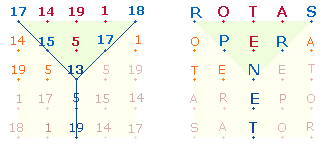
The 11 letters
of the "cup with stem" read from top right, left and down (5-3-3): SATOR PERNET
– The Creator weaves (his works) permanently.
The 4values of the two words are:
|
|
NS |
FS |
sm |
FV1 |
FV2 |
sm |
total |
|
SATOR |
69 |
54 |
123 |
26 |
11 |
37 |
160 |
|
PERNET |
74 |
67 |
141 |
39 |
67 |
106 |
247 |
|
|
143 |
121 |
264 |
65 |
78 |
143 |
407 |
|
65:78 = 13*(5:6); 264:143 = 11*(24:13) |
|||||||
|
247 = 13*19 = NT |
|||||||
The sum 37
associates with PER and NET with the same NS 37.
5.
The
results are astonishing and among the hidden mysteries of the Square. The
letter Y was certainly not part of the Latin
alphabet when the SATOR Square was designed,
but it was to be discovered later. However, the word groups PER and NET
form a cross which could be read in such a
way that the E was repeated so that the
notion of the letter Y was not really
required:
|
|
The equivalent letters of
the product 13*19 are NT, the two consonants of the word NET.
6.
The
two words SATOR PERNET are an anagram for PATER NOSTER. Here Shakespeare might have seen a
connection between the NS 39 of his initials –
the "cup contents" – and their NS+FS 57 – the NS of PATER. The NS ratio of the frame of the cup to the
"contents" is 104:39 = 13*(8:3). It
may be a reason why Shakespeare liked the number 83.
He may feel that his life was securely held in the hand of God.
The Y-figure
is contained four times in the SATOR Square,
which Shakespeare may have inspired to design the four Y-words and connect with
the four words YIOS THEO, YIOS YPSISTOU of
the Angel's annunciation speech to the Virgin Mary.
Written: July 2014
